Effective SEO Marketing Strategy 2025: Step-by-Step


SEO is the backbone of online success in a world where over 8.5 billion searches are conducted daily. It's not just about appearing in search results; it's about ensuring your business is the one that customers find. But here's the kicker: many businesses pour resources into pay-per-click ads, only to realize they are missing out on sustainable growth. The real game-changer? A well-crafted SEO strategy that builds long-term organic visibility and drives results without ongoing expense. Your approach to SEO can either elevate your brand or leave you lost in the digital crowd.
Table Of Contents
- Why Seo Marketing Strategy Matters
- Key Components Of Seo Marketing Strategy
- Step-by-Step Seo Implementation Guide
- Measuring And Optimizing Results
Quick Summary
| Takeaway | Explanation |
|---|---|
| Foundation for Sustainable Growth | A well-crafted SEO strategy generates long-term organic visibility and return on investment, unlike paid advertising. This sustainable approach continues to benefit businesses over time. |
| Competitive Advantage Through Intent Matching | Aligning content with user search intent is crucial to attracting potential customers, as it creates relevance that both search engines and users reward. |
| Resource Optimization and ROI | A strategic SEO approach focuses efforts on high-value keywords and actions that offer the greatest return, eliminating wasted resources on ineffective tactics. |
| Alignment With Business Objectives | SEO strategies should be tied to business goals, ensuring that increased traffic translates into conversions and sales rather than just numbers. |
| Measurement and Refinement Framework | Establishing KPIs, utilizing the right reporting tools, and analyzing data continuously transforms SEO into a data-driven practice that yields ongoing improvements. |
Why SEO Marketing Strategy Matters

In today's digital landscape, an SEO marketing strategy isn't just a nice-to-have—it's a business necessity. With over 8.5 billion searches processed by Google daily, your website's visibility determines whether potential customers find your business or your competitors. Let's explore why a strategic approach to SEO delivers meaningful business results rather than just random traffic.
Foundation for Sustainable Growth
A well-crafted SEO strategy creates a foundation for sustainable business growth. Unlike paid advertising that stops delivering results the moment you stop paying, organic search visibility continues working for your business around the clock. This compounding effect means the work you do today continues generating returns months and years into the future.
Strategic SEO focuses on building authority and relevance that search engines reward over time. Rather than chasing algorithm changes or implementing disconnected tactics, businesses with clear SEO strategies can weather updates and continue attracting qualified visitors. This long-term approach transforms SEO from a temporary traffic boost into a reliable business asset.
Competitive Advantage Through Intent Matching
Understanding and mapping search intent is perhaps the most powerful element of an effective SEO marketing strategy. When you align your content and offerings with what your target audience is actually searching for, you create perfect matches between business solutions and customer problems.
Consider this: 68% of online experiences begin with a search engine. Your competitors are actively working to capture those searchers. Without a strategic approach to SEO, you're essentially allowing competitors to intercept potential customers who are actively looking for solutions you provide.
A comprehensive SEO strategy involves analyzing not just what people search for, but why they search and what they hope to accomplish. This strategic intent matching creates relevance that both search engines and users reward.
Resource Optimization and ROI
Random SEO activities without strategic direction waste precious resources. Many businesses make the mistake of producing content that never ranks, building links that don't move the needle, or optimizing for keywords that don't convert.
A proper SEO marketing strategy prevents this waste by focusing efforts where they'll generate the greatest return. By identifying high-value keywords, understanding competitive gaps, and prioritizing actions based on potential impact, businesses can maximize their SEO investment.
This strategic approach addresses the fundamental question: "Where should we focus our limited SEO resources to generate the greatest business impact?" Rather than spreading efforts thinly across every possible optimization, strategic SEO concentrates resources where they create meaningful results.
Alignment With Business Objectives
Perhaps most importantly, an SEO marketing strategy ensures alignment between search optimization efforts and actual business goals. Traffic alone doesn't pay bills—conversions, leads, and sales do.
Strategic SEO starts by identifying what business outcomes matter most, then works backward to determine which search opportunities support those outcomes. This might mean prioritizing product-focused keywords for e-commerce businesses or informational content that generates leads for service businesses.
Without this strategic alignment, SEO efforts risk becoming disconnected from business reality. You might successfully increase traffic to your website, but if those visitors don't become customers, the SEO work provides little actual value.
A comprehensive SEO strategy also integrates with other marketing channels, ensuring consistent messaging and user experiences across every touchpoint. This integration transforms SEO from an isolated technical activity into a core component of your overall marketing approach.
In today's competitive digital landscape, random SEO tactics simply aren't enough. Businesses that develop and execute coherent SEO marketing strategies consistently outperform those implementing disconnected optimization efforts. By building a strategic foundation, matching search intent, optimizing resources, and aligning with business objectives, your SEO strategy becomes a powerful driver of sustainable growth and competitive advantage.
Key Components of SEO Marketing Strategy
A comprehensive SEO marketing strategy consists of several interconnected elements that work together to improve your online visibility. Understanding these core components helps you build a framework that drives sustainable results rather than pursuing random optimization tactics. Let's examine the essential building blocks of an effective SEO strategy.
Keyword Research and Intent Analysis
Keyword research remains the foundation of any successful SEO marketing strategy. However, modern keyword research goes beyond just finding high-volume search terms. It involves understanding the intent behind searches and aligning your content with what users actually want to accomplish.
Start by identifying your seed keywords—the core terms related to your business, products, or services. Then expand these into a comprehensive list using keyword research tools like Ahrefs or SEMrush. The most valuable keywords sit at the intersection of:
- Relevant search volume
- Reasonable competition levels
- Clear user intent that matches your business offerings
- Conversion potential
Organize your keywords by search intent categories: informational, navigational, commercial, and transactional. This intent mapping helps you create content that satisfies user needs at different stages of their journey, from initial research to final purchase decision.
Technical SEO Framework
Technical SEO creates the foundation that allows search engines to effectively crawl, index, and understand your website. Without sound technical SEO, even the best content may struggle to rank. Key technical elements include:
Site structure and crawlability: Ensure your website has a logical hierarchy that search engines can navigate efficiently. This includes proper internal linking, an optimized sitemap, and robots.txt configuration.
Page speed optimization: Fast-loading pages improve both user experience and search rankings. Compress images, leverage browser caching, and minimize code to enhance speed.
Mobile responsiveness: With Google's mobile-first indexing, your site must provide an excellent experience on smartphones and tablets.
Core Web Vitals: These metrics measure loading performance, interactivity, and visual stability—all critical factors in Google's ranking algorithm.
While technical SEO often requires specialized knowledge, addressing these fundamentals creates a solid foundation for your other SEO efforts.
Content Strategy and Creation
Content remains the vehicle that delivers your message to both users and search engines. An effective content strategy for SEO includes:
Content mapping: Align specific content pieces with keyword targets and user journey stages. This ensures you're creating content that serves both SEO goals and user needs.
Content formats: Develop diverse content types including blog posts, landing pages, guides, videos, and infographics to capture different user preferences.
Content quality: Focus on creating thorough, accurate, and valuable content that genuinely answers user questions better than competing pages.
Content optimization: Structure your content with proper headings, paragraph breaks, and semantic elements that help search engines understand your topics.
Remember that modern SEO content must be comprehensive rather than just keyword-stuffed. Create resources that thoroughly address user needs, incorporating relevant subtopics and related questions.
Off-Page Authority Building
While on-page and technical factors are within your direct control, off-page elements like backlinks continue to significantly influence rankings. A strategic approach to off-page SEO includes:
Link earning: Create content assets worthy of natural links instead of pursuing manipulative link schemes.
Digital PR: Develop newsworthy content and build relationships with publishers to earn mentions and backlinks.
Brand building: Cultivate a strong brand presence that naturally attracts mentions across the web.
Local citations: For businesses with physical locations, maintain consistent business information across directories and review sites.
The quality of links matters significantly more than quantity. A few links from authoritative, relevant sites typically outweigh many low-quality backlinks.
Measurement and Refinement Framework
An SEO marketing strategy isn't complete without a system for measuring results and refining your approach. Establish:
Key performance indicators (KPIs): Define what success looks like beyond just rankings—include traffic, conversions, and revenue metrics.
Reporting systems: Implement analytics tools that track progress against your KPIs and provide actionable insights.
Testing methodology: Create a framework for testing changes and measuring their impact before full implementation.
Adaptation processes: Establish regular reviews to refine your strategy based on performance data and search engine updates.
This measurement framework transforms SEO from guesswork into a data-driven practice that continuously improves over time.
By integrating these five components—keyword research, technical SEO, content strategy, off-page authority, and measurement—you create a cohesive SEO marketing strategy that drives sustainable results. Rather than chasing trends or implementing random tactics, this structured approach ensures your SEO efforts contribute meaningfully to your business objectives.
Step-by-Step SEO Implementation Guide
Transforming SEO strategy into action requires a systematic approach. This implementation guide breaks down the process into manageable steps that help you move from planning to execution efficiently. By following this framework, you'll create a structured path toward improved search visibility and avoid the common pitfall of random, disconnected SEO activities.
Step 1: Conduct a Comprehensive SEO Audit
Before making changes, you need an accurate picture of your current SEO performance. A thorough audit examines your website's strengths, weaknesses, and opportunities across several dimensions:
Technical health check: Evaluate site speed, mobile responsiveness, crawlability, indexation issues, and structural problems that might be holding back your performance. Tools like Google Search Console reveal indexation issues, while PageSpeed Insights identifies performance bottlenecks.
Content inventory: Catalog existing content and assess its quality, relevance, and performance. Look for thin content, outdated information, and pages that could benefit from consolidation or expansion.
Competitive analysis: Identify which competitors rank for your target terms and analyze what they're doing effectively. This provides valuable insights into content gaps and backlink opportunities.
Backlink profile assessment: Examine your existing backlinks to identify toxic links that might need disavowal and strong links that could be leveraged for further opportunities.
This audit becomes your baseline, highlighting the highest-priority items that need immediate attention and establishing metrics against which you'll measure progress.
Step 2: Define Clear Goals and KPIs
With your audit complete, establish specific, measurable SEO goals aligned with broader business objectives. Effective SEO goals might include:
- Increasing organic traffic to specific product pages by X% within six months
- Improving conversion rates from organic traffic by X%
- Ranking on page one for X number of high-priority keywords
- Reducing bounce rates on key landing pages by X%
For each goal, identify the key performance indicators (KPIs) you'll track. Remember that rankings alone don't tell the full story—include metrics that connect SEO performance to actual business outcomes like leads, sales, or revenue.
Step 3: Develop Your Keyword Strategy
Build upon your initial keyword research by creating a structured keyword implementation plan:
- Group related keywords into thematic clusters
- Prioritize keywords based on a combination of search volume, competition, and conversion potential
- Map each keyword or keyword group to specific pages on your site
- Identify content gaps where new pages are needed
For existing pages, determine which need optimization for currently targeted keywords versus which should target new keywords entirely. This mapping exercise creates a clear roadmap for your content optimization efforts.
Step 4: Fix Technical SEO Issues
Address the technical issues identified in your audit, starting with those that have the greatest potential impact on performance:
Critical fixes first: Resolve issues that prevent proper indexing or severely impact user experience, such as broken links, 404 errors, or duplicate content problems.
Site architecture improvements: Enhance your internal linking structure to distribute page authority effectively and help search engines understand your content hierarchy.
Schema markup implementation: Add appropriate structured data to help search engines better understand your content and potentially earn rich snippets in search results.
Page speed optimization: Implement recommended performance improvements, focusing particularly on Core Web Vitals metrics that directly impact search rankings.
Document all technical changes to help track their impact on performance and provide reference for future optimizations.
Step 5: Execute Your Content Strategy
With technical issues addressed, focus on implementing your content plan:
Optimize existing content: Update and enhance underperforming pages by improving keyword targeting, adding valuable information, updating outdated facts, and enhancing readability and engagement factors.
Create new strategic content: Develop content for identified gaps, focusing on comprehensive coverage of topics rather than just keyword insertion. Quality and depth matter more than quantity.
Implement a content calendar: Schedule regular content creation and updates, ensuring consistent attention to your SEO content needs across all important topics and keywords.
Remember that effective SEO content serves both search engines and users—it must be technically optimized while also providing genuine value to your audience.
Step 6: Build Authority Through Off-Page Tactics
Implement your off-page strategy to build domain authority and enhance rankings:
Outreach and relationship building: Identify potential linking partners and develop customized outreach approaches that emphasize mutual benefit.
Content promotion: Create systematic processes for promoting new content through social media, email, and other channels to increase visibility and natural link earning potential.
Local SEO implementation: For businesses with physical locations, ensure consistent NAP (Name, Address, Phone) information across directories and actively manage local reviews.
Track all outreach efforts and resulting placements to understand which approaches yield the best results for your business.
Step 7: Measure, Learn, and Iterate

Implement regular monitoring and refinement processes to continuously improve your SEO performance:
Weekly monitoring: Track rankings, traffic, and conversion metrics to identify unexpected changes requiring immediate attention.
Monthly analysis: Conduct deeper reviews of performance against goals, identifying successful tactics worth expanding and underperforming areas needing adjustment.
Quarterly strategy refinement: Review overall progress toward goals and make larger strategic adjustments based on accumulated data and changing market conditions.
This systematic approach transforms SEO from a one-time project into an ongoing process of continuous improvement that adapts to evolving search algorithms, market conditions, and business needs.
Measuring and Optimizing Results
Implementing an SEO strategy is only half the journey. Without proper measurement and optimization, you can't determine what's working, what isn't, and where to focus your efforts moving forward. This section explores how to effectively measure SEO performance and use those insights to continuously refine your approach.
Establishing Your Measurement Framework
A robust measurement framework begins with selecting the right metrics that align with your business objectives. While vanity metrics like raw traffic numbers might look impressive, they don't always translate to business results. Instead, focus on metrics that demonstrate real business impact:
Traffic quality indicators: Beyond total visits, examine metrics like pages per session, average session duration, and bounce rate to understand if your SEO is attracting genuinely interested visitors.
Conversion metrics: Track how organic visitors convert into leads, subscribers, or customers. Set up goal tracking in Google Analytics to monitor form submissions, email sign-ups, purchases, or other valuable actions.
Revenue attribution: Where possible, attribute actual revenue to organic search traffic to calculate true return on investment from your SEO efforts.
Engagement signals: Assess how visitors interact with your content through metrics like comments, social shares, and return visits.
The most effective measurement approaches connect these metrics to specific SEO activities, allowing you to determine which strategies deliver the most significant results for your specific situation.
Essential SEO Reporting Tools
Robust measurement requires the right tools. A comprehensive SEO measurement toolkit typically includes:
Google Analytics: The foundation of most SEO reporting, Google Analytics provides detailed information about traffic sources, user behavior, and conversions. The newer GA4 version offers enhanced features for tracking user journeys across devices.
Google Search Console: This free tool provides invaluable data directly from Google about how your site appears in search results, including impressions, clicks, average position, and technical issues that might affect performance.
Rank tracking tools: Solutions like SERP Robot or Ahrefs Rank Tracker monitor your rankings for targeted keywords over time, showing progress and identifying opportunities.
Competitive analysis tools: Services such as SEMrush or Similarweb provide insights into competitor performance, allowing you to benchmark your results against others in your industry.
Custom dashboards: Many organizations benefit from creating custom dashboards that aggregate data from multiple sources to provide a unified view of SEO performance.
The goal isn't to collect data for its own sake but to gather actionable insights that inform strategic decisions.
Interpreting Data for Strategic Insights
Collecting data is one thing; extracting meaningful insights is another. When analyzing SEO performance data:
Look for patterns and trends rather than focusing on day-to-day fluctuations. Search rankings naturally vary, but consistent directional movement over weeks or months reveals genuine progress or problems.
Segment your data to uncover deeper insights. For example, analyze performance by content type, topic clusters, device type, or user demographics to identify specific areas of opportunity.
Connect cause and effect by correlating SEO activities with subsequent performance changes. This helps establish which tactics deliver the most significant results for your specific situation.
Identify both strengths and weaknesses to understand what's working well (so you can do more of it) and what needs improvement (so you can address issues).
Effective data interpretation transforms raw numbers into strategic direction, guiding where to focus your optimization efforts.
Optimizing Based on Performance Data
The ultimate purpose of measurement is to inform optimization. A data-driven optimization approach includes:
Content refinement: Identify underperforming content that ranks on page two or lower and enhance it by adding depth, improving keyword targeting, or addressing user experience issues.
Opportunity expansion: When you discover content that performs exceptionally well, create additional content on related topics to capitalize on that demonstrated strength.
Technical fine-tuning: Use performance data to prioritize technical improvements that will have the greatest impact on user experience and search visibility.
Conversion optimization: When pages receive good traffic but don't convert well, implement A/B testing to improve call-to-action effectiveness, form design, or other conversion elements.
The most successful SEO programs operate as continuous improvement cycles, where measurement insights drive optimization actions that lead to improved performance, generating new insights that inform the next round of optimizations.
Adapting to Algorithm Changes
Search engines constantly evolve their algorithms. A robust measurement framework helps you identify the impact of these changes on your specific website and adapt accordingly:
Monitor for sudden changes in traffic, rankings, or engagement that might indicate algorithm updates affecting your site.
Analyze patterns across affected pages to identify common factors that might be triggering positive or negative algorithm responses.
Test targeted changes on a small scale before implementing them broadly, using your measurement framework to assess their impact.
By maintaining a data-driven approach to SEO, you can respond strategically to algorithm changes rather than reactively chasing each update.
Effective measurement and optimization transform SEO from a guessing game into a strategic business function with predictable, improvable results. The organizations that excel at SEO are typically those that excel at measuring, learning from, and acting upon performance data in a structured, continuous way.
Frequently Asked Questions
What is an SEO marketing strategy?
An SEO marketing strategy is a structured plan designed to optimize a website's visibility on search engines. It involves keyword research, content creation, technical SEO, link building, and performance measurement to drive organic traffic and conversions.
Why is keyword research important in SEO?
Keyword research is crucial because it helps identify the phrases and terms potential customers use to search for products or services. Understanding this intent allows businesses to create targeted content that meets users' needs, increasing the chances of attracting qualified traffic.
How can I measure the effectiveness of my SEO efforts?
You can measure the effectiveness of your SEO efforts by tracking key performance indicators (KPIs) such as organic traffic, conversion rates, bounce rates, and keyword rankings. Tools like Google Analytics and Google Search Console can provide valuable insights into how your website is performing.
What role does technical SEO play in my overall strategy?
Technical SEO is the backbone of an SEO strategy, ensuring that search engines can effectively crawl, index, and rank your website. It includes optimizing site speed, ensuring mobile responsiveness, and resolving any indexing issues that could hinder search visibility.
Elevate Your SEO Strategy with BabyLoveGrowth.ai
Feeling overwhelmed by the complexities of implementing an effective SEO marketing strategy? You're not alone! Many businesses struggle with the foundational elements that drive sustainable growth—like keyword research, technical SEO, and content optimization. The challenge often lies in aligning these components with your unique business goals while managing resources efficiently.
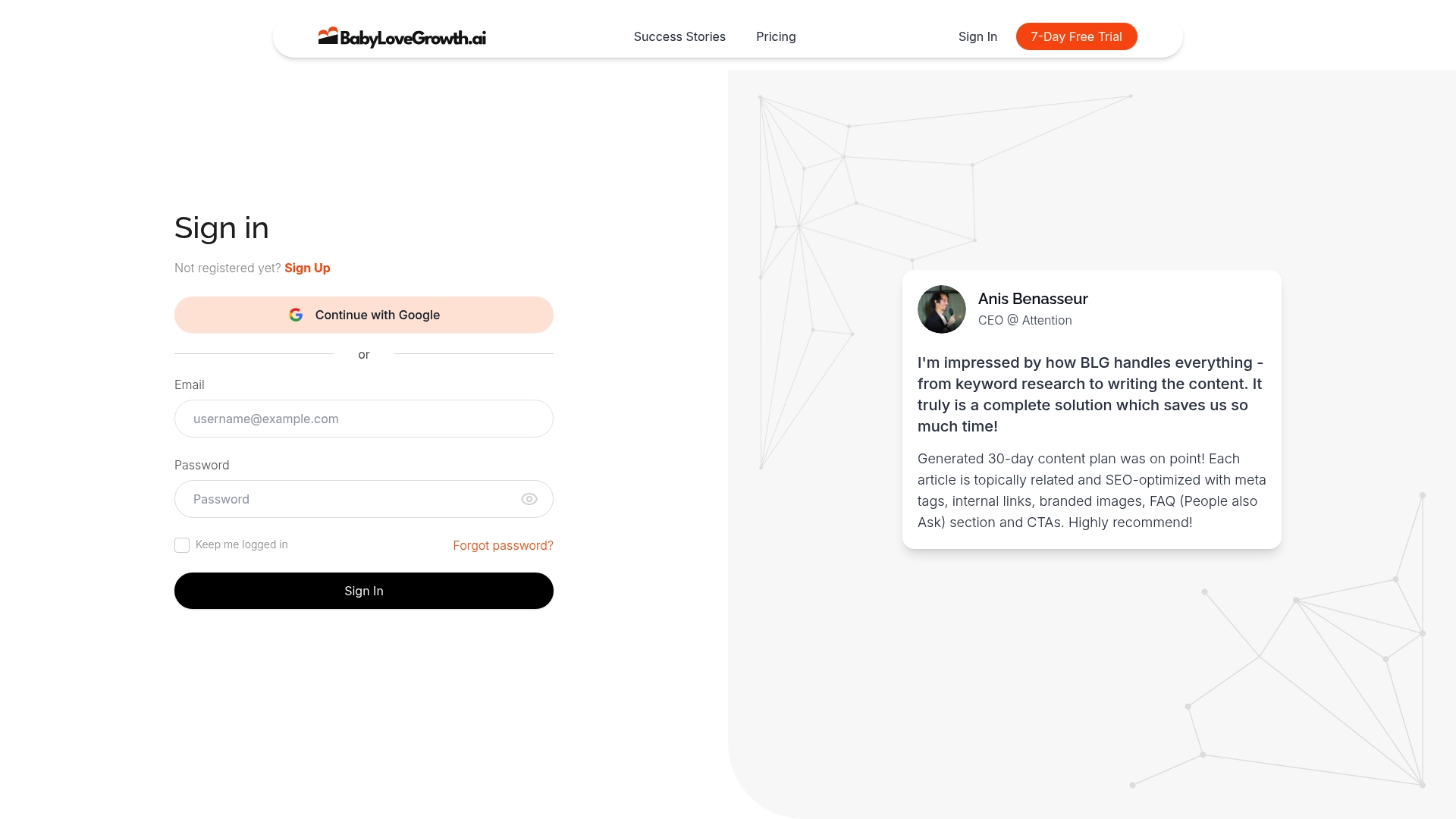
At BabyLoveGrowth.ai, we simplify this process for you. Our AI-driven platform not only automates SEO content generation but also provides comprehensive business analysis and a customized 30-day content plan tailored to your needs. Imagine focusing on your core operations while our system efficiently creates SEO-optimized articles that attract organic traffic and engage your audience.
Don’t let your competitors outrank you! Start transforming your digital presence today. Visit BabyLoveGrowth.ai and experience the power of a strategic SEO approach that guarantees long-term visibility and growth. Act NOW and unlock your path to sustained online success!
Recommended Articles
- 4Ps of Marketing Examples: Unpacking the Essentials for Effective Strategies
- SEO for Electricians: Easy Strategies for More Leads
- The Ultimate Guide to Dofollow Backlink: Boost Your SEO Strategy
- Understanding Content Generation Meaning: Trends for 2025
- Local SEO Definition: Simple Guide for Business Growth
Smart SEO,
Faster Growth!
Most Read Articles
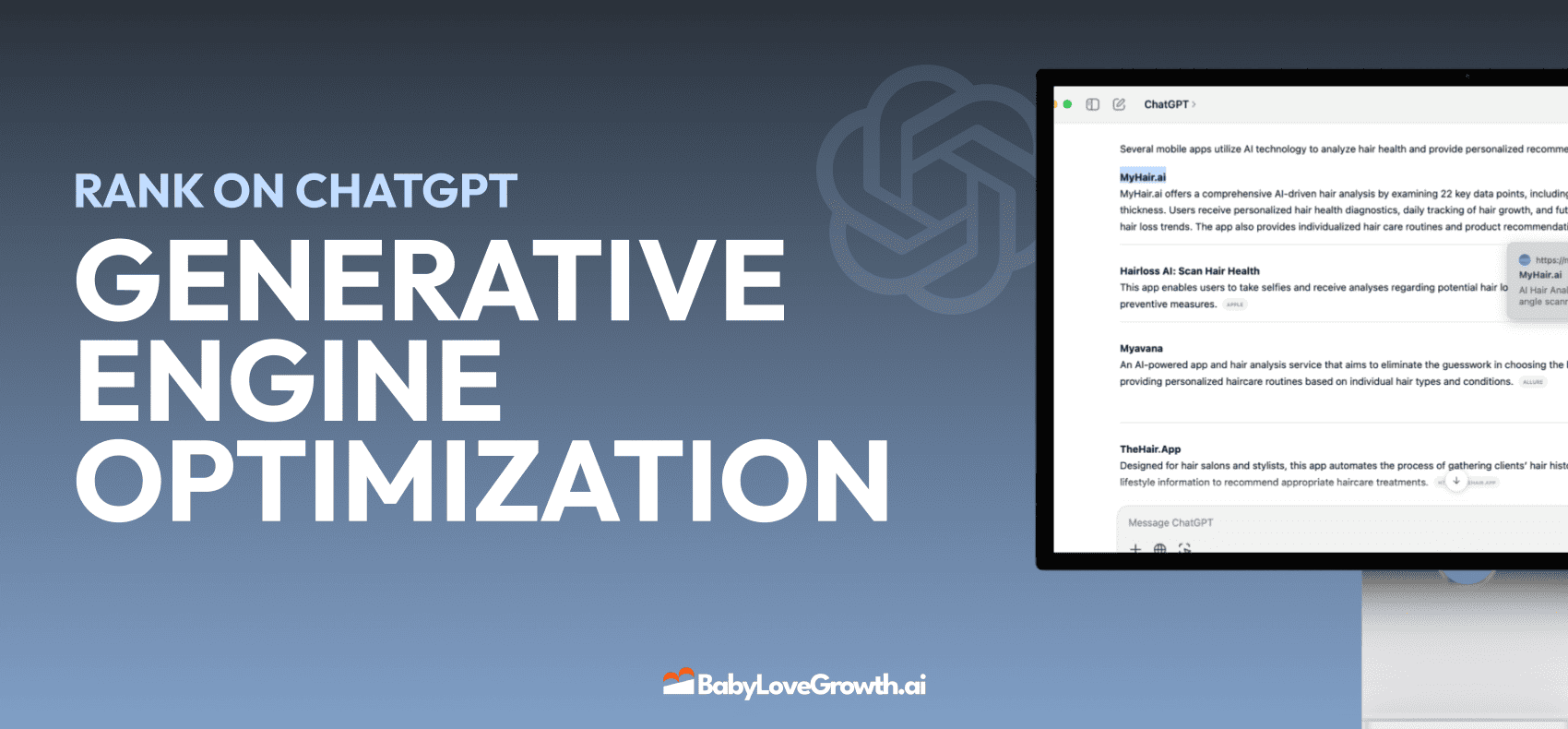
Generative Engine Optimization (GEO)
Learn how Generative Engine Optimization (GEO) helps your content rank in AI search engines like ChatGPT and Google AI. This comprehensive guide explains the differences between SEO and GEO, why it matters for your business, and practical steps to implement GEO strategies for better visibility in AI-generated responses.
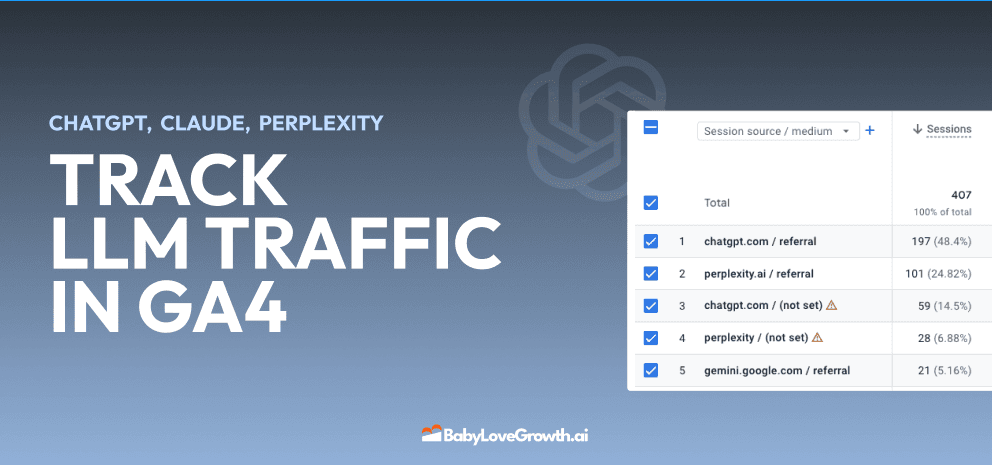
Track LLM Traffic in Google Analytics 4 (GA4)
Learn how to track and analyze traffic from AI sources like ChatGPT, Claude, Perplexity, and Google Gemini in Google Analytics 4. This step-by-step guide shows you how to set up custom filters to monitor AI-driven traffic and make data-driven decisions for your content strategy.
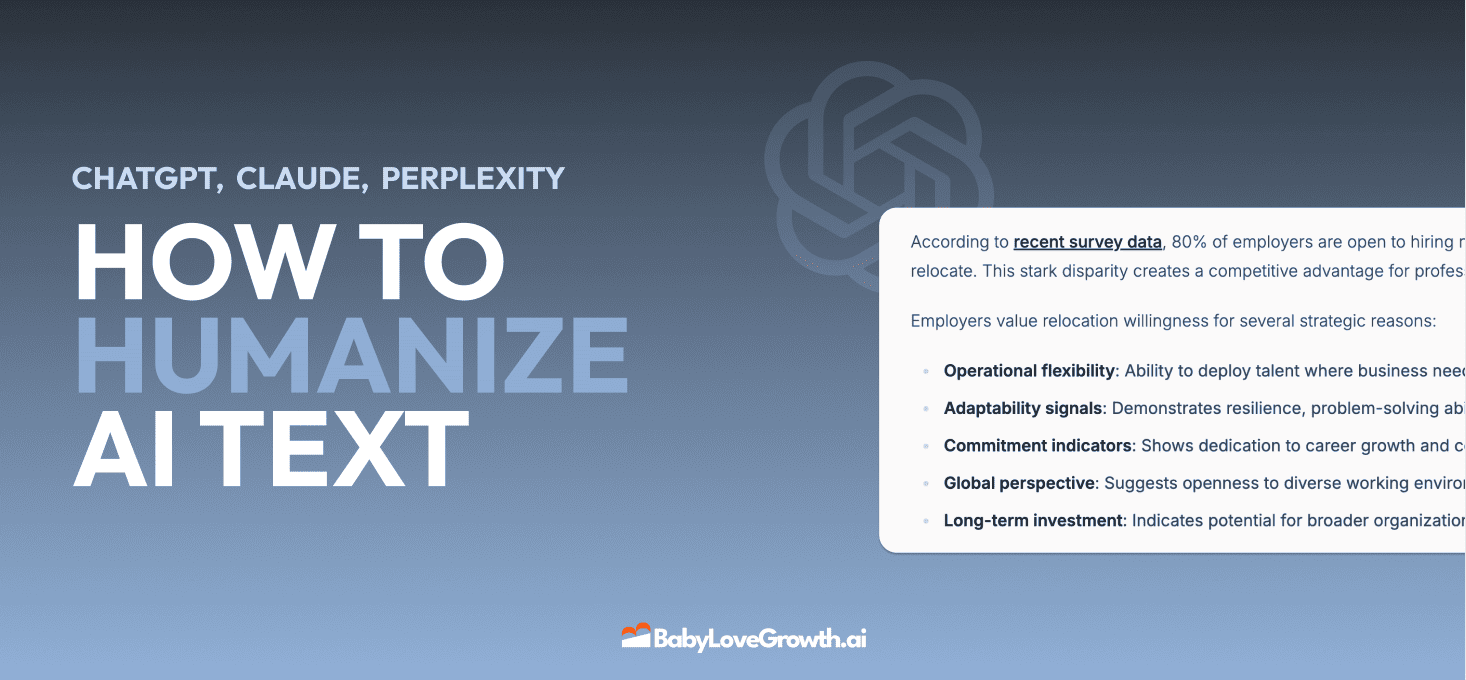
How to Humanize AI Text with Instructions
Learn practical techniques to make AI-generated content sound more natural and human. This guide covers active voice, direct addressing, concise writing, and other proven strategies to transform robotic text into engaging content.
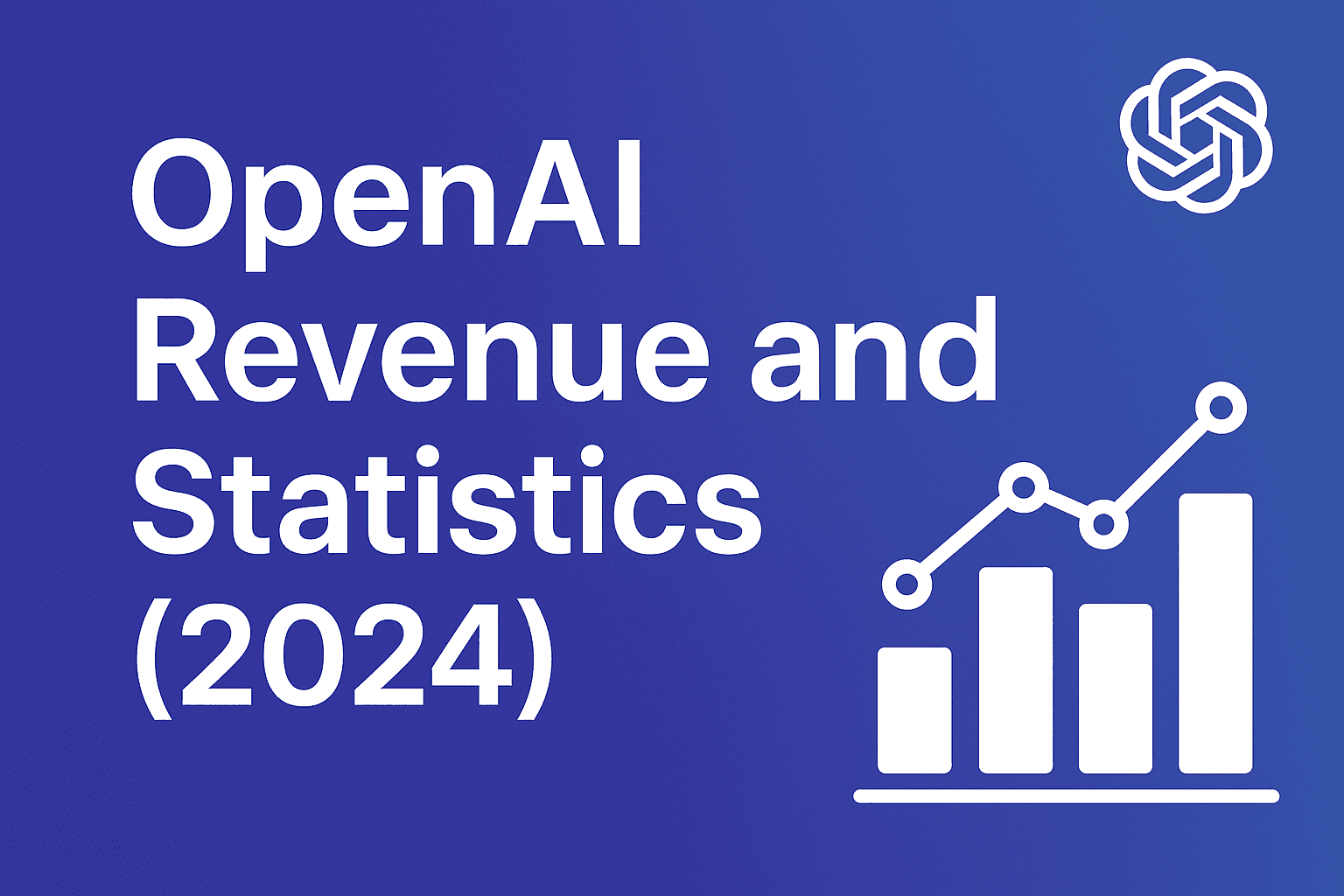
Open AI Revenue and Statistics (2024)
Comprehensive analysis of OpenAI financial performance, user engagement, and market position in 2023. Discover key statistics including $20B valuation, $1B projected revenue, and 100M+ monthly active users.